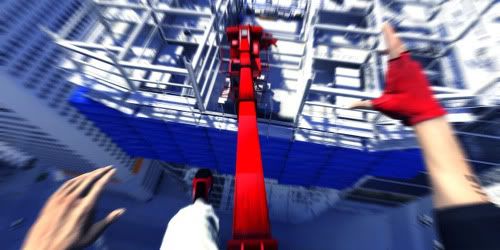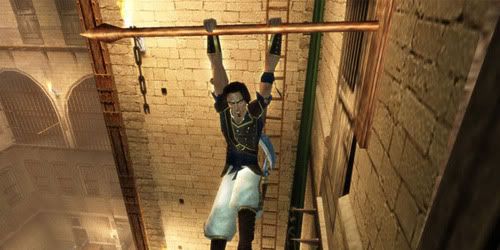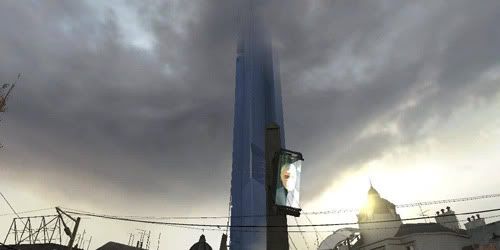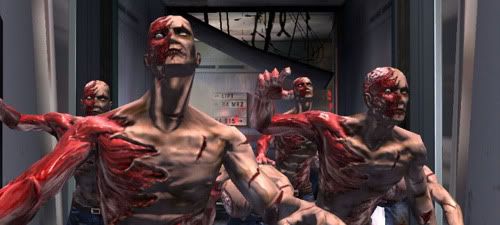She tells us from the beginning: it's about flow.

Mirror's Edge is a fascinating game in many respects. It's a first-person platformer, which is unique enough, but it's through its mechanical and narrative focus on replicating parkour/free running that the game truly shines as something new and interesting.
The problem with platformers is that they too often devolve into frustrating puzzles where players calculate and repeatedly attempt a series of jumps and other special moves, failing and iterating their technique until they find the intended solution and reach their goal. (Perhaps it's thus fitting that platformers are often referred to as "adventure games" on consoles, leading to genre confusion/ignorance.) But while true adventure games are often predicated on the satisfaction of solving a puzzle after much mental anguish, platformers are usually intended as much more visceral, continuous experiences. Games with flow.

It's the same problem that has plagued shooters and led to the introduction of health regeneration in Halo and others, and in platformers of the time rewind mechanic of The Sands of Time and the ultimate quickload in the latest Prince of Persia. And yet many of these games still have a natural rhythm of starting and stopping, still have a pace that lulls and rises. I don't know of any game that has demanded a constant pace and flow as Mirror's Edge--a game that knows nothing of the above devices.
Mirror's Edge is game so focused on the constant adrenaline rush--so focused on keeping players running that even the protagonist's title is "runner"--that players never have the opportunity to stop and contemplate their options, analyze their surroundings and figure out the best method of jumps and climbs and wall runs to get to where they're trying to go. Almost any time you stop in Mirror's Edge, the "blues" (antagonistic police) show up quickly, forcing you to keep running (or engage in the game's feeble combat system, which is both poor and out-of-place, although the guns are suitably lethal that if you are willing to use them combat is at least laughably easy).
This isn't intrinsically a bad thing. In fact it's an interesting scenario, putting players in an unfamiliar situation where they're on the run, not the bad guys. Most gamers are used to being gods compared to their enemies, who are only dangerous in mass numbers; Mirror's Edge manages to make players truly feel hunted, as if they need to run in order to survive, which is certainly an accomplishment to be applauded.
The problem is that the game's spaces don't take this into account. They're designed like most platformer spaces, with lots of red herrings and only one or a few routes to the goal. It's extremely easy to miscalculate a jump and fall to your death, and even if you make it's hard to be sure you're going the right way. And you don't have any time to think, because the blues are coming. You have to run and run, and you don't know where you're going, or what you're supposed to do. And so the game becomes simply frustrating instead of tense.

Part of the problem is the game's art direction. Its minimalism is brilliant but I can't help but wish the game's art director had learned a bit from Valve and Half-Life, the masters of subtly drawing players' attention. Throughout Mirror's Edge their are voice overs that theoretically point you towards your goal--some distant building, usually--but frequently the building blends in with its surroundings (despite the saturated and limited color scheme allowing for strong definition, as the runner's sight mechanic demonstrates), and even if you can locate it the route is usually so opaque and roundabout that sighting your eventual goal is next to worthless.
This, I assume, was the genesis of the "runner's sight", the mechanic whereby helpful ramps, bars, walls, etc. turn strongly red as the player approaches, explained as the protagonist's runner intuition. It feels like a cheat (and indeed the hardest difficulty mandates turning it off), a way to guide players because the developers' couldn't figure out a better way. It's such a blatant way of directing players, putting up a giant glowing sign saying Go Here!, that I sometimes felt offended, like I was being treated as a child. But most of the time I didn't, because most of the time I needed those clues because there weren't any others in the game. And sometimes even when I had those clues I still didn't know where to go.
But ultimately I think it's a problem of unfocused goals. It seems the developers just weren't sure what kind of game they were trying to make, how their game was that different from most platformers, and what other changes they needed to make to make those differences work. When you know where to go, Mirror's Edge approaches brilliance, the experience reaching towards the exhilaration and terror the game seems to be aiming for. But every time you screw up, the experience is ruined; and you screw up a lot.

At times while I was playing it I almost wished the game was something that might be termed a rail platformer, a platforming version of arcade rail shooters like House of the Dead, whereby instead of shooting the zombies at each screen you simply jumped at the right time, or made simple choices to go left or right, etc., at various points. A node-based platformer, in which the mechanics of actually getting a jump right were left behind. Because that seemed the easiest way to actually accomplish the experience Mirror's Edge aims and fails to achieve.
But that speculation got me thinking about a much greater problem I have with Mirror's Edge, one that gnawed away at me as I played the game at a place low enough it didn't even register consciously for some time. And that's the fact that in a game about free running, it seems to forget about the free.



0 comments:
Post a Comment